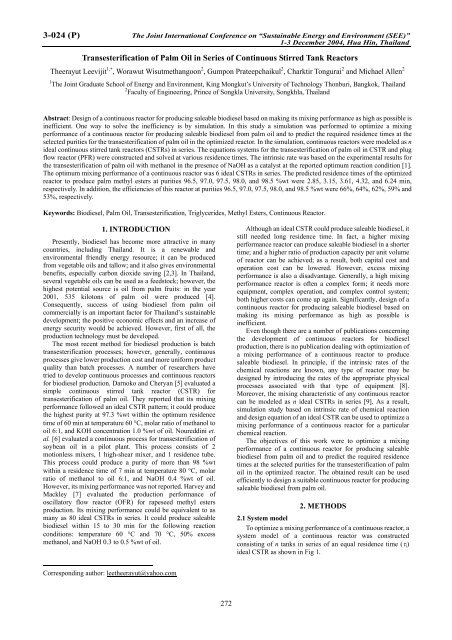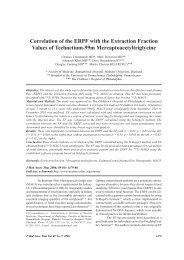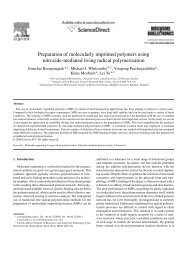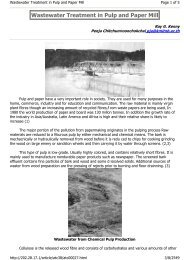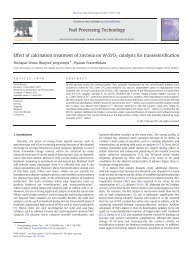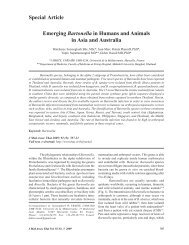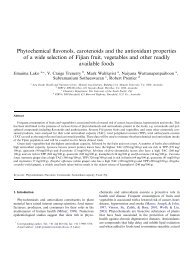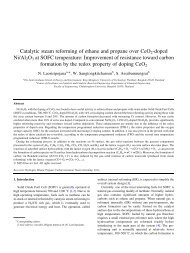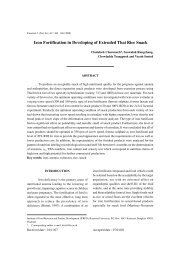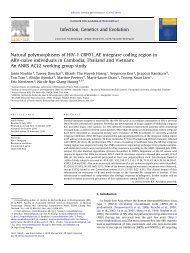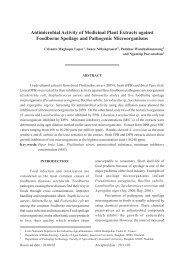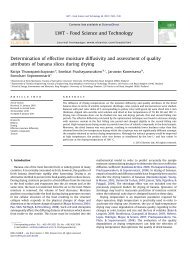Transesterification of Palm Oil in Series of Continuous ... - ThaiScience
Transesterification of Palm Oil in Series of Continuous ... - ThaiScience
Transesterification of Palm Oil in Series of Continuous ... - ThaiScience
You also want an ePaper? Increase the reach of your titles
YUMPU automatically turns print PDFs into web optimized ePapers that Google loves.
3-024 (P) The Jo<strong>in</strong>t International Conference on “Susta<strong>in</strong>able Energy and Environment (SEE)”<br />
1-3 December 2004, Hua H<strong>in</strong>, Thailand<br />
<strong>Transesterification</strong> <strong>of</strong> <strong>Palm</strong> <strong>Oil</strong> <strong>in</strong> <strong>Series</strong> <strong>of</strong> Cont<strong>in</strong>uous Stirred Tank Reactors<br />
Theerayut Leevijit 1,* , Worawut Wisutmethangoon 2 , Gumpon Prateepchaikul 2 , Charktir Tongurai 2 and Michael Allen 2<br />
1 The Jo<strong>in</strong>t Graduate School <strong>of</strong> Energy and Environment, K<strong>in</strong>g Mongkut’s University <strong>of</strong> Technology Thonburi, Bangkok, Thailand<br />
2 Faculty <strong>of</strong> Eng<strong>in</strong>eer<strong>in</strong>g, Pr<strong>in</strong>ce <strong>of</strong> Songkla University, Songkhla, Thailand<br />
Abstract: Design <strong>of</strong> a cont<strong>in</strong>uous reactor for produc<strong>in</strong>g saleable biodiesel based on mak<strong>in</strong>g its mix<strong>in</strong>g performance as high as possible is<br />
<strong>in</strong>efficient. One way to solve the <strong>in</strong>efficiency is by simulation. In this study a simulation was performed to optimize a mix<strong>in</strong>g<br />
performance <strong>of</strong> a cont<strong>in</strong>uous reactor for produc<strong>in</strong>g saleable biodiesel from palm oil and to predict the required residence times at the<br />
selected purities for the transesterification <strong>of</strong> palm oil <strong>in</strong> the optimized reactor. In the simulation, cont<strong>in</strong>uous reactors were modeled as n<br />
ideal cont<strong>in</strong>uous stirred tank reactors (CSTRs) <strong>in</strong> series. The equations systems for the transesterification <strong>of</strong> palm oil <strong>in</strong> CSTR and plug<br />
flow reactor (PFR) were constructed and solved at various residence times. The <strong>in</strong>tr<strong>in</strong>sic rate was based on the experimental results for<br />
the transesterification <strong>of</strong> palm oil with methanol <strong>in</strong> the presence <strong>of</strong> NaOH as a catalyst at the reported optimum reaction condition [1].<br />
The optimum mix<strong>in</strong>g performance <strong>of</strong> a cont<strong>in</strong>uous reactor was 6 ideal CSTRs <strong>in</strong> series. The predicted residence times <strong>of</strong> the optimized<br />
reactor to produce palm methyl esters at purities 96.5, 97.0, 97.5, 98.0, and 98.5 %wt were 2.85, 3.15, 3.61, 4.32, and 6.24 m<strong>in</strong>,<br />
respectively. In addition, the efficiencies <strong>of</strong> this reactor at purities 96.5, 97.0, 97.5, 98.0, and 98.5 %wt were 66%, 64%, 62%, 59% and<br />
53%, respectively.<br />
Keywords: Biodiesel, <strong>Palm</strong> <strong>Oil</strong>, <strong>Transesterification</strong>, Triglycerides, Methyl Esters, Cont<strong>in</strong>uous Reactor.<br />
1. INTRODUCTION<br />
Presently, biodiesel has become more attractive <strong>in</strong> many<br />
countries, <strong>in</strong>clud<strong>in</strong>g Thailand. It is a renewable and<br />
environmental friendly energy resource; it can be produced<br />
from vegetable oils and tallow; and it also gives environmental<br />
benefits, especially carbon dioxide sav<strong>in</strong>g [2,3]. In Thailand,<br />
several vegetable oils can be used as a feedstock; however, the<br />
highest potential source is oil from palm fruits: <strong>in</strong> the year<br />
2001, 535 kilotons <strong>of</strong> palm oil were produced [4].<br />
Consequently, success <strong>of</strong> us<strong>in</strong>g biodiesel from palm oil<br />
commercially is an important factor for Thailand’s susta<strong>in</strong>able<br />
development; the positive economic effects and an <strong>in</strong>crease <strong>of</strong><br />
energy security would be achieved. However, first <strong>of</strong> all, the<br />
production technology must be developed.<br />
The most recent method for biodiesel production is batch<br />
transesterification processes; however, generally, cont<strong>in</strong>uous<br />
processes give lower production cost and more uniform product<br />
quality than batch processes. A number <strong>of</strong> researchers have<br />
tried to develop cont<strong>in</strong>uous processes and cont<strong>in</strong>uous reactors<br />
for biodiesel production. Darnoko and Cheryan [5] evaluated a<br />
simple cont<strong>in</strong>uous stirred tank reactor (CSTR) for<br />
transesterification <strong>of</strong> palm oil. They reported that its mix<strong>in</strong>g<br />
performance followed an ideal CSTR pattern; it could produce<br />
the highest purity at 97.3 %wt with<strong>in</strong> the optimum residence<br />
time <strong>of</strong> 60 m<strong>in</strong> at temperature 60 °C, molar ratio <strong>of</strong> methanol to<br />
oil 6:1, and KOH concentration 1.0 %wt <strong>of</strong> oil. Nouredd<strong>in</strong>i et.<br />
al. [6] evaluated a cont<strong>in</strong>uous process for transesterification <strong>of</strong><br />
soybean oil <strong>in</strong> a pilot plant. This process consists <strong>of</strong> 2<br />
motionless mixers, 1 high-shear mixer, and 1 residence tube.<br />
This process could produce a purity <strong>of</strong> more than 98 %wt<br />
with<strong>in</strong> a residence time <strong>of</strong> 7 m<strong>in</strong> at temperature 80 °C, molar<br />
ratio <strong>of</strong> methanol to oil 6:1, and NaOH 0.4 %wt <strong>of</strong> oil.<br />
However, its mix<strong>in</strong>g performance was not reported. Harvey and<br />
Mackley [7] evaluated the production performance <strong>of</strong><br />
oscillatory flow reactor (OFR) for rapeseed methyl esters<br />
production. Its mix<strong>in</strong>g performance could be equivalent to as<br />
many as 80 ideal CSTRs <strong>in</strong> series. It could produce saleable<br />
biodiesel with<strong>in</strong> 15 to 30 m<strong>in</strong> for the follow<strong>in</strong>g reaction<br />
conditions: temperature 60 °C and 70 °C, 50% excess<br />
methanol, and NaOH 0.3 to 0.5 %wt <strong>of</strong> oil.<br />
Correspond<strong>in</strong>g author: leetheerayut@yahoo.com<br />
272<br />
Although an ideal CSTR could produce saleable biodiesel, it<br />
still needed long residence time. In fact, a higher mix<strong>in</strong>g<br />
performance reactor can produce saleable biodiesel <strong>in</strong> a shorter<br />
time; and a higher ratio <strong>of</strong> production capacity per unit volume<br />
<strong>of</strong> reactor can be achieved; as a result, both capital cost and<br />
operation cost can be lowered. However, excess mix<strong>in</strong>g<br />
performance is also a disadvantage. Generally, a high mix<strong>in</strong>g<br />
performance reactor is <strong>of</strong>ten a complex form; it needs more<br />
equipment, complex operation, and complex control system;<br />
both higher costs can come up aga<strong>in</strong>. Significantly, design <strong>of</strong> a<br />
cont<strong>in</strong>uous reactor for produc<strong>in</strong>g saleable biodiesel based on<br />
mak<strong>in</strong>g its mix<strong>in</strong>g performance as high as possible is<br />
<strong>in</strong>efficient.<br />
Even though there are a number <strong>of</strong> publications concern<strong>in</strong>g<br />
the development <strong>of</strong> cont<strong>in</strong>uous reactors for biodiesel<br />
production, there is no publication deal<strong>in</strong>g with optimization <strong>of</strong><br />
a mix<strong>in</strong>g performance <strong>of</strong> a cont<strong>in</strong>uous reactor to produce<br />
saleable biodiesel. In pr<strong>in</strong>ciple, if the <strong>in</strong>tr<strong>in</strong>sic rates <strong>of</strong> the<br />
chemical reactions are known, any type <strong>of</strong> reactor may be<br />
designed by <strong>in</strong>troduc<strong>in</strong>g the rates <strong>of</strong> the appropriate physical<br />
processes associated with that type <strong>of</strong> equipment [8].<br />
Moreover, the mix<strong>in</strong>g characteristic <strong>of</strong> any cont<strong>in</strong>uous reactor<br />
can be modeled as n ideal CSTRs <strong>in</strong> series [9]. As a result,<br />
simulation study based on <strong>in</strong>tr<strong>in</strong>sic rate <strong>of</strong> chemical reaction<br />
and design equation <strong>of</strong> an ideal CSTR can be used to optimize a<br />
mix<strong>in</strong>g performance <strong>of</strong> a cont<strong>in</strong>uous reactor for a particular<br />
chemical reaction.<br />
The objectives <strong>of</strong> this work were to optimize a mix<strong>in</strong>g<br />
performance <strong>of</strong> a cont<strong>in</strong>uous reactor for produc<strong>in</strong>g saleable<br />
biodiesel from palm oil and to predict the required residence<br />
times at the selected purities for the transesterification <strong>of</strong> palm<br />
oil <strong>in</strong> the optimized reactor. The obta<strong>in</strong>ed result can be used<br />
efficiently to design a suitable cont<strong>in</strong>uous reactor for produc<strong>in</strong>g<br />
saleable biodiesel from palm oil.<br />
2. METHODS<br />
2.1 System model<br />
To optimize a mix<strong>in</strong>g performance <strong>of</strong> a cont<strong>in</strong>uous reactor, a<br />
system model <strong>of</strong> a cont<strong>in</strong>uous reactor was constructed<br />
consist<strong>in</strong>g <strong>of</strong> n tanks <strong>in</strong> series <strong>of</strong> an equal residence time (τ i)<br />
ideal CSTR as shown <strong>in</strong> Fig 1.
3-024 (P) The Jo<strong>in</strong>t International Conference on “Susta<strong>in</strong>able Energy and Environment (SEE)”<br />
1-3 December 2004, Hua H<strong>in</strong>, Thailand<br />
Fig. 1 System model <strong>of</strong> a cont<strong>in</strong>uous reactor as n ideal CSTRs<br />
<strong>in</strong> series.<br />
Thus, the total residence time <strong>of</strong> a cont<strong>in</strong>uous reactor or n<br />
ideal CSTRs <strong>in</strong> series is<br />
= n<br />
τ τ<br />
(1)<br />
t<br />
∑ i<br />
i=<br />
1<br />
where τ t is total residence time <strong>of</strong> n ideal CSTRs <strong>in</strong> series<br />
(s); τ i is a residence time <strong>of</strong> tank i (s); and n is number <strong>of</strong> tanks.<br />
2.2 <strong>Transesterification</strong> <strong>of</strong> palm oil <strong>in</strong> an ideal CSTR<br />
In order to predict the amount <strong>of</strong> methyl esters produced<br />
either <strong>in</strong> an ideal CSTR or <strong>in</strong> n ideal CSTRs <strong>in</strong> series at any<br />
residence time, the system <strong>of</strong> calculation equations for<br />
transesterification <strong>of</strong> palm oil <strong>in</strong> an ideal CSTR must be<br />
constructed and solved.<br />
The system <strong>of</strong> calculation equations for transesterification<br />
<strong>of</strong> palm oil <strong>in</strong> an ideal CSTR was constructed based on: the<br />
design equation <strong>of</strong> an ideal CSTR operated at a steady state [9]<br />
and the second order rate equations without the shunt reaction<br />
characteriz<strong>in</strong>g the stepwise reactions for transesterification <strong>of</strong><br />
vegetable oils [10,11]. In addition, generally, the volume <strong>of</strong><br />
liquid-phase reaction changes <strong>in</strong>significantly dur<strong>in</strong>g the<br />
reaction. Which is unlike gas-phase reaction. The constant<br />
volume is <strong>of</strong>ten applied for liquid-phase reaction [9]. Moreover,<br />
observations <strong>in</strong> batch transesterification <strong>of</strong> palm oil did not f<strong>in</strong>d<br />
a significant change <strong>of</strong> the volume <strong>of</strong> reaction mixture dur<strong>in</strong>g<br />
the reaction. As a result, the system <strong>of</strong> calculation equations<br />
was also based on constant volume <strong>of</strong> reaction mixture. The<br />
obta<strong>in</strong>ed system <strong>of</strong> calculation equations is shown as follow<strong>in</strong>g.<br />
C TG,<br />
Out + ( k1CTGC<br />
A − k2CDGCME<br />
) τ<br />
= CTG,<br />
In<br />
C<br />
C<br />
DG,<br />
Out<br />
MG,<br />
Out<br />
+ ( −k<br />
C<br />
− k C<br />
4<br />
1<br />
TG<br />
MG<br />
+ ( −k<br />
C<br />
6<br />
3<br />
− k C<br />
GL<br />
C + k C<br />
DG<br />
C<br />
C<br />
A<br />
ME<br />
) τ<br />
) τ<br />
2<br />
4<br />
DG<br />
C + k C<br />
A<br />
ME<br />
C<br />
MG<br />
ME<br />
C<br />
ME<br />
+ k C<br />
3<br />
5<br />
DG<br />
+ k C<br />
C<br />
MG<br />
A<br />
C<br />
A<br />
= C<br />
= C<br />
DG,<br />
In<br />
MG,<br />
In<br />
C GL,<br />
Out + ( −k5CMGC<br />
A + k6CGLCME<br />
) τ<br />
= CGL,<br />
In<br />
C<br />
C<br />
ME,Out<br />
A,<br />
Out<br />
+ ( − k C<br />
+ k C<br />
4<br />
+ ( k C<br />
1<br />
4<br />
1<br />
TG<br />
− k C<br />
TG<br />
MG<br />
C + k C<br />
C<br />
C<br />
A<br />
ME<br />
C − k C<br />
MG<br />
A<br />
ME<br />
2<br />
2<br />
DG<br />
− k C<br />
5<br />
5<br />
DG<br />
C<br />
+ k C<br />
C<br />
MG<br />
ME<br />
MG<br />
ME<br />
− k C<br />
C + k C<br />
A<br />
+ k C<br />
3<br />
6<br />
3<br />
6<br />
C<br />
C − k C<br />
A<br />
DG<br />
DG<br />
GL<br />
GL<br />
A<br />
C<br />
C<br />
C<br />
A<br />
ME<br />
ME<br />
)τ<br />
) τ<br />
= C<br />
= C<br />
ME,<br />
In<br />
A,<br />
In<br />
where C is mole concentration (mol/L); τ is residence time<br />
(s); k 1 to k 6 are k<strong>in</strong>etic rate constants (L/mol.s); subscript TG,<br />
DG, MG, GL, ME, and A are denoted for triglycerides (TG),<br />
diglycerides (DG), monoglycerides (MG), glycerolr (GL),<br />
methyl esters (ME) and alcohol; subscript In is denoted for<br />
enter<strong>in</strong>g condition; subscript Out is denoted for exit condition.<br />
In addition, an ideal CSTR is referred to a tank reactor that is<br />
completely mixed; thus, the concentration is identical<br />
everywhere with<strong>in</strong> the tank and similar to the concentration at<br />
the exit po<strong>in</strong>t [9].<br />
The reaction rate constants, k1 to k 6, for transesterification <strong>of</strong><br />
palm oil with methanol <strong>in</strong> the presence <strong>of</strong> NaOH as catalyst at<br />
atmospheric pressure were obta<strong>in</strong>ed experimentally from our<br />
previous work. The experiment was based on the reported<br />
optimum condition for transesterification <strong>of</strong> palm oil as<br />
follows: 6:1 molar ratio <strong>of</strong> alcohol to oil, temperature 60 °C,<br />
and catalyst concentration 1% wt <strong>of</strong> oil [1]. The obta<strong>in</strong>ed<br />
(2)<br />
273<br />
reaction rate constants are shown <strong>in</strong> Table 1. These reaction rate<br />
constants provided a good fit with experimental results. The<br />
overall goodness <strong>of</strong> fit to predict a weight percentage <strong>of</strong> ME <strong>in</strong><br />
the product dur<strong>in</strong>g the reaction was quantified through two<br />
standards: the correlation coefficient (R 2 ) and the mean relative<br />
deviation (MRD). The R 2 was 0.9936 and the MRD was<br />
1.835%.<br />
Table 1 The reaction rate constants (L/mol.s)<br />
k1 k2 k3<br />
k4 k5 k6 1.057×10 -2<br />
0.000<br />
1.184×10 -1<br />
8.187×10 -2<br />
1.310×10 -1<br />
2.011×10 -3<br />
The system <strong>of</strong> equations, Eq. (2), can be rewritten <strong>in</strong> matrix<br />
form <strong>of</strong> system <strong>of</strong> nonl<strong>in</strong>ear equations as follow<strong>in</strong>g.<br />
⎡ ∂g1<br />
∂g1<br />
∂g1<br />
∂g1<br />
∂g1<br />
∂g1<br />
⎤ ⎧ ⎫<br />
⎢<br />
⎥⎧C<br />
⎫<br />
C<br />
1<br />
1,<br />
In<br />
∂C<br />
⎪ ⎪ ⎪<br />
⎢ 1 ∂C2<br />
∂C3<br />
∂C4<br />
∂C5<br />
∂C6<br />
⎥⎪<br />
⎪<br />
C<br />
⎪ ⎪C<br />
2 2,<br />
In⎪<br />
⎢∂g<br />
2 ∂g2<br />
∂g2<br />
∂g2<br />
∂g2<br />
∂g2<br />
⎥<br />
⎪ ⎪ ⎪ ⎪<br />
⎢<br />
⎥ C ⎪C<br />
3 3,<br />
In ⎪<br />
⎢<br />
∂C1<br />
∂C2<br />
∂C3<br />
∂C4<br />
∂C5<br />
∂C6<br />
⎥⎨<br />
⎬ = ⎨ ⎬<br />
⎢<br />
⎥⎪C4<br />
⎪ ⎪C4,<br />
In<br />
M<br />
⎪<br />
⎢<br />
⎥⎪C<br />
⎪ ⎪C<br />
⎪<br />
5 5,<br />
In<br />
⎢∂g6<br />
∂g6<br />
∂g6<br />
∂g6<br />
∂g6<br />
∂g6<br />
⎥⎪<br />
⎪ ⎪ ⎪<br />
⎪⎩<br />
⎪<br />
⎢<br />
⎥<br />
C6⎭<br />
⎪⎩<br />
⎪<br />
⎣∂C<br />
∂C<br />
∂C<br />
∂C<br />
∂C<br />
∂C<br />
C6,<br />
In<br />
1 2 3 4 5 6 ⎦<br />
⎭<br />
where g1 to g6 are the functions that represent the terms on<br />
the left hand side <strong>of</strong> equations system, Eq. (2), respectively; C1 to C6 are the exit mole concentrations <strong>of</strong> TG, DG, MG, GL, ME,<br />
and alcohol; C1,In to C6,In are the enter<strong>in</strong>g mole concentrations<br />
<strong>of</strong> TG, DG, MG, GL, ME, and alcohol.<br />
Eq. (3) is 6 unknowns and 6 equations system. The<br />
unknowns are the exit mole concentrations, C1 to C6. Generally,<br />
the approximate solutions <strong>of</strong> the above system <strong>of</strong> nonl<strong>in</strong>ear<br />
equations can be solved by various numerical techniques [12].<br />
A couple <strong>of</strong> least-squares regression technique and the ability <strong>of</strong><br />
solver tool <strong>in</strong> Micros<strong>of</strong>t Excel 2000 program also can be used to<br />
solve the above system <strong>of</strong> nonl<strong>in</strong>ear equations, which was used<br />
to f<strong>in</strong>d the best approximate solutions that gave the m<strong>in</strong>imize<br />
value <strong>of</strong> sum <strong>of</strong> error squares (E 2 ) as shown <strong>in</strong> the follow<strong>in</strong>g<br />
equation.<br />
2<br />
⎡ ∂gi<br />
∂gi<br />
∂gi<br />
⎤<br />
,<br />
1<br />
2<br />
3<br />
6 ⎢Ci<br />
In − ( C + C + C ⎥<br />
2<br />
∂C1<br />
∂C2<br />
∂C3<br />
E = ∑ ⎢<br />
⎥<br />
i= 1 ⎢ ∂gi<br />
∂gi<br />
∂gi<br />
⎥<br />
⎢ + C4<br />
+ C5<br />
+ C6)<br />
⎥<br />
⎣ ∂C4<br />
∂C5<br />
∂C6<br />
⎦<br />
However, to ensure that this method provides correct<br />
solutions, the error square <strong>of</strong> each equation must be checked to<br />
evaluate the correctness <strong>of</strong> the obta<strong>in</strong>ed solutions. This value<br />
should as near zero as possible. The observed error squares <strong>in</strong><br />
this simulation ranged from 2.27×10 -17 to 6.07×10 -4 (3)<br />
(4)<br />
. The<br />
biggest error square occurred when the biggest residence time<br />
was used <strong>in</strong> calculation (60 m<strong>in</strong>). These results confirmed that<br />
this method could be used to solve the above system <strong>of</strong><br />
nonl<strong>in</strong>ear equations while the correct solutions were obta<strong>in</strong>ed.<br />
On the other hand, if the other numerical methods were used,<br />
the largest acceptability <strong>of</strong> the error squares also had to be given<br />
<strong>in</strong> a computer code.<br />
Furthermore, it is a nature <strong>of</strong> a numerical technique that<br />
<strong>in</strong>itial guesses affect the obta<strong>in</strong>ed results. Some <strong>in</strong>itial guesses<br />
give divergent results; some <strong>in</strong>itial guesses give convergent<br />
results. For the latter case, different <strong>in</strong>itial guesses can also give<br />
different results. Hence, different <strong>in</strong>itial guesses were used. The<br />
ranges <strong>of</strong> results for reaction rate constants were obta<strong>in</strong>ed.<br />
However, the ranges were very narrow.<br />
A purity <strong>of</strong> biodiesel is represented by the weight percentage<br />
(5)
3-024 (P) The Jo<strong>in</strong>t International Conference on “Susta<strong>in</strong>able Energy and Environment (SEE)”<br />
1-3 December 2004, Hua H<strong>in</strong>, Thailand<br />
<strong>of</strong> ME <strong>in</strong> the product as shown by the follow<strong>in</strong>g equation<br />
W ME<br />
Purity (%wt) =<br />
× 100%<br />
WME<br />
+ WTG<br />
+ WDG<br />
+ WMG<br />
where WME, WTG, WDG, WMG are weight percentages <strong>of</strong> ME,<br />
TG, DG, and MG on a glycerol-free basis (%wt).<br />
The weight percentages <strong>of</strong> TG, DG, MG, and ME on a<br />
glycerol-free basis were calculated from the known exit mole<br />
concentrations <strong>of</strong> ME, TG, DG, and MG coupled with their<br />
molecular weights. These molecular weights were calculated<br />
from the known fatty acids <strong>of</strong> palm oil [13]; they were 849.5,<br />
597.0, 344.5, and 284.5 kg/kmol, respectively.<br />
2.3 <strong>Transesterification</strong> <strong>of</strong> palm oil <strong>in</strong> n ideal CSTRs <strong>in</strong> series<br />
To predict the amount <strong>of</strong> methyl esters produced <strong>in</strong> n ideal<br />
CSTRs <strong>in</strong> series at any specified residence time, the system <strong>of</strong><br />
calculation equation for transesterification <strong>of</strong> palm oil <strong>in</strong> an<br />
ideal CSTR must be solved sequentially. For example, the exit<br />
mole concentrations <strong>of</strong> the 1 st tank were determ<strong>in</strong>ed by solv<strong>in</strong>g<br />
the system <strong>of</strong> calculation equations. Then, the exit mole<br />
concentrations <strong>of</strong> the 1 st tank were used as the enter<strong>in</strong>g mole<br />
concentrations for the 2 nd tank. Aga<strong>in</strong>, the exit mole<br />
concentrations <strong>of</strong> the 2 nd tank were determ<strong>in</strong>ed by solv<strong>in</strong>g the<br />
system <strong>of</strong> calculation equations. Similarly, the exit mole<br />
concentrations <strong>of</strong> the 2 nd tank were used as the enter<strong>in</strong>g mole<br />
concentrations for the 3 rd tank and so on. As a result, by<br />
sequential solv<strong>in</strong>g <strong>of</strong> the system <strong>of</strong> calculation equations, the<br />
exit mole concentrations <strong>of</strong> n th tank can be determ<strong>in</strong>ed.<br />
2.4 Reactor efficiency<br />
To know the efficiency <strong>of</strong> a cont<strong>in</strong>uous reactor that its<br />
mix<strong>in</strong>g performance equivalent to n ideal CSTRs <strong>in</strong> series, the<br />
conversion yields at various residence times <strong>in</strong> a plug flow<br />
reactor (PFR) must be determ<strong>in</strong>ed. Consequently, the system <strong>of</strong><br />
calculation equations for transesterification <strong>of</strong> palm oil <strong>in</strong> PFR<br />
was constructed based on the same conditions as construct<strong>in</strong>g<br />
the system <strong>of</strong> calculation equations for transesterification <strong>of</strong><br />
palm oil <strong>in</strong> an ideal CSTR, but it was based on the design<br />
equation <strong>of</strong> PFR [9]. The obta<strong>in</strong>ed system <strong>of</strong> calculation<br />
equations is shown as follow<strong>in</strong>g.<br />
dCTG<br />
= −k1<br />
CTGCA<br />
+ k2CDGCME<br />
dτ<br />
dCDG<br />
= k1<br />
CTGCA<br />
− k2CDGCME<br />
− k3CDGCA<br />
+ k4CMGCME<br />
dτ<br />
dCMG<br />
= k3<br />
CDGCA<br />
− k4CMGCME<br />
− k5CMGCA<br />
+ k6CGLCME<br />
dτ<br />
dCGL<br />
= k5CMGCA<br />
− k6CGLCME<br />
(6)<br />
dτ<br />
dCME<br />
= k1CTGC<br />
A − k2CDGCME<br />
+ k3CDGC<br />
A<br />
dτ<br />
dC<br />
dτ<br />
A<br />
− k C<br />
4<br />
= − k C<br />
1<br />
TG<br />
MG<br />
A<br />
C<br />
ME<br />
+ k C<br />
C + k C<br />
2<br />
5<br />
DG<br />
C<br />
MG<br />
ME<br />
C − k C<br />
A<br />
+ k4CMGCME<br />
− k5CMGC<br />
A + k6C<br />
GLCME<br />
where C is mole concentration (mol/L); τ is residence time<br />
(s); k1 to k6 are k<strong>in</strong>etic rate constants (L/mol.s); and subscript<br />
TG, DG, MG, GL, ME, and A are denoted for TG, DG, MG, GL,<br />
ME and alcohol.<br />
6<br />
− k C<br />
3<br />
A computer code for f<strong>in</strong>ite different method was employed<br />
on program MATLAB 6.1 to solve the system <strong>of</strong> calculation<br />
equations for transeterification <strong>of</strong> palm oil <strong>in</strong> a PFR. The<br />
system <strong>of</strong> design equations was solved for residence time up to<br />
60 m<strong>in</strong>. In fact, generally for numerical technique, the size <strong>of</strong><br />
step time (∆t) used <strong>in</strong> simulation affects the obta<strong>in</strong>ed results.<br />
DG<br />
GL<br />
C<br />
A<br />
C<br />
ME<br />
Purity (%wt)<br />
274<br />
The effect <strong>of</strong> size <strong>of</strong> step time was tested. However, step time<br />
less than 1 sec gave <strong>in</strong>significant different results compared to<br />
step time 1 sec. As a result, step time 1 sec was used for<br />
simulation.<br />
100<br />
95<br />
90<br />
85<br />
80<br />
3. RESULTS AND DISCUSSION<br />
<strong>Transesterification</strong> <strong>of</strong> ref<strong>in</strong>ed palm oil <strong>in</strong> cont<strong>in</strong>uous reactor<br />
modeled as n ideal CSTRs <strong>in</strong> series and PFR were simulated.<br />
The <strong>in</strong>tr<strong>in</strong>sic rate was based on our previous result for<br />
transesterification <strong>of</strong> palm oil at temperature 60 °C and NaOH<br />
concentration 1 %wt <strong>of</strong> oil. The enter<strong>in</strong>g molar ratio <strong>of</strong><br />
methanol to oil was specified at 6:1.<br />
For transesterification <strong>of</strong> ref<strong>in</strong>ed palm oil <strong>in</strong> n ideal CSTRs<br />
<strong>in</strong> series, the system <strong>of</strong> calculation equations was solved for<br />
various values <strong>of</strong> n; however, the results <strong>of</strong> n <strong>in</strong> the range <strong>of</strong> 1 to<br />
7 were presented here. These equations were solved <strong>in</strong> the<br />
range <strong>of</strong> residence time (τi) from 5 sec to 60 m<strong>in</strong>. For<br />
transesterification <strong>of</strong> ref<strong>in</strong>ed palm oil <strong>in</strong> PFR, the system <strong>of</strong><br />
calculation equations was solved for residence time up to 60<br />
m<strong>in</strong>, while step time (∆t) equal to 1 sec was used.<br />
The purities at various total residence times up to 20 m<strong>in</strong> <strong>of</strong><br />
n ideal CSTRs <strong>in</strong> series and PFR are shown <strong>in</strong> Fig. 2. An ideal<br />
CSTR could produce the highest purity at 97.8 %wt. Increas<strong>in</strong>g<br />
<strong>of</strong> residence time more than 60 m<strong>in</strong>, the purity was <strong>in</strong>creased<br />
slowly. Darnoko and Cheryan [5] also found that the highest<br />
purity <strong>in</strong> their experiment was 97.3 %wt. For n >1 and PFR,<br />
they could produce the same highest purity at 98.7 %wt.<br />
However, the required residence times were different. The<br />
required residence times to yield the selected purities at 96.0,<br />
96.5, 97.0, 97.5, 98.0, and 98.5 %wt <strong>of</strong> n ideal CSTRs <strong>in</strong> series<br />
were extracted. These data are shown <strong>in</strong> Fig. 3.<br />
0 5 10 15 20<br />
Total Residence Time (m<strong>in</strong>)<br />
Fig. 2 Predicted purity for the transesterification <strong>of</strong> palm oil <strong>in</strong><br />
series <strong>of</strong> CSTRs at molar ratio 6:1, temperature 60 °C, NaOH<br />
concentration 1 %wt <strong>of</strong> oil; (▲) 1-CSTR; (×) 2-CSTRs; (+)<br />
3-CSTRs; (◊) 4-CSTRs; (∆) 5-CSTRs; (○) 6-CSTRs; (□)<br />
7-CSTRs; (●) PFR.
3-024 (P) The Jo<strong>in</strong>t International Conference on “Susta<strong>in</strong>able Energy and Environment (SEE)”<br />
1-3 December 2004, Hua H<strong>in</strong>, Thailand<br />
Required Residence Time (m<strong>in</strong>)<br />
50<br />
45<br />
40<br />
35<br />
30<br />
25<br />
20<br />
15<br />
10<br />
5<br />
0<br />
1 2 3 4 5 6 7<br />
n-CSTRs <strong>in</strong> <strong>Series</strong><br />
Fig. 3 Predicted required residence times to produce the<br />
selected purities (%wt) for the transesterification <strong>of</strong> palm oil <strong>in</strong><br />
series <strong>of</strong> CSTRs at molar ratio 6:1, temperature 60 °C, NaOH<br />
concentration 1 %wt <strong>of</strong> oil; (◊) 96.0; (□) 96.5; (∆) 97.0; (×)<br />
97.5; (○) 98.0; (●) 98.5.<br />
275<br />
Decreased Residence Time (%)<br />
60<br />
50<br />
40<br />
30<br />
20<br />
10<br />
0<br />
3<br />
4<br />
5<br />
n-CSTRs <strong>in</strong> series<br />
Fig. 4 Predicted decreased residence times at the selected<br />
purities for the transesterification <strong>of</strong> palm oil <strong>in</strong> series <strong>of</strong><br />
CSTRs at molar ratio 6:1, temperature 60 °C, NaOH<br />
concentration 1 %wt <strong>of</strong> oil.<br />
Reactor Efficiency (%)<br />
6<br />
96.0<br />
96.5<br />
97.0<br />
97.5<br />
98.0<br />
98.5<br />
Purity (%wt)<br />
The decreased residence time (%) at any n <strong>of</strong> tanks <strong>of</strong><br />
The efficiency <strong>of</strong> reactor (η) at a purity level x is the ratio <strong>of</strong><br />
the required residence time to yield this level <strong>of</strong> conversion <strong>in</strong> a<br />
<strong>in</strong>terest and selected purity level x was computed from<br />
PFR to that <strong>of</strong> the reactor as shown <strong>in</strong> follow<strong>in</strong>g equation [15].<br />
⎛ τ 1 − ⎞<br />
Decreased Residence Time (%) = ⎜ n − τn<br />
⎟ × 100<br />
n,<br />
x ⎜ ⎟ (7)<br />
⎝ τn−1<br />
⎠x<br />
where τ is a required residence time, subscript n is denoted<br />
for the number <strong>of</strong> tanks <strong>of</strong> <strong>in</strong>terest, subscript n-1 is denoted for<br />
one tank less than the number <strong>of</strong> tanks <strong>of</strong> <strong>in</strong>terest, and subscript<br />
x is denoted for a purity level x.<br />
Fig. 4 shows the significant range for the decreased<br />
residence times: the range <strong>of</strong> n between 3 to 6 and the range <strong>of</strong><br />
purity between 96.0 to 98.5 %wt. When n = 2, the decreased<br />
residence times were more than 70%; they are not shown here.<br />
On the other hand, when n > 6, the decreased residence times<br />
were too small; they are not also shown here. The shaded area<br />
<strong>in</strong> Fig. 4 represents the decreased residence time <strong>of</strong> less than<br />
10%.<br />
The patterns <strong>of</strong> decreased residence time at all selected<br />
⎛ τ<br />
pf<br />
⎞<br />
η = ⎜ ⎟<br />
x ⎜ τ ⎟<br />
(8)<br />
⎝ ⎠x<br />
where η is efficiency <strong>of</strong> reactor, τ is required residence time,<br />
subscript pf is denoted for PFR, and subscript x is denoted for<br />
purity level x.<br />
The calculated efficiencies <strong>of</strong> a cont<strong>in</strong>uous reactor that its<br />
mix<strong>in</strong>g performance equivalent to 2 until 6 ideal CSTRs <strong>in</strong><br />
series are shown <strong>in</strong> Fig. 5. The shaded area represents the<br />
efficiencies <strong>of</strong> more than 60%. The efficiencies <strong>of</strong> 6 ideal<br />
CSTRs <strong>in</strong> series at purities 96.5, 97.0, 97.5, 98.0, and 98.5 %wt<br />
were 66%, 64%, 62%, 59% and 53%, respectively.<br />
conversion yields were similar. The great decrease could be<br />
obta<strong>in</strong>ed when n = 2. A large decrease still could be obta<strong>in</strong>ed<br />
when n ≤ 5. However, when n = 6; the decreased residence<br />
100<br />
90<br />
times at selected purities 96.0, 96.5, 97.0, 97.5, and 98.0 %wt<br />
80<br />
were around 8%; the decreased residence times at selected<br />
70<br />
purities 98.5 %wt was around 12%. These results revealed that<br />
for purity ≤ 98.0 %wt, <strong>in</strong>creas<strong>in</strong>g <strong>of</strong> n gave a significant<br />
60<br />
decrease <strong>of</strong> required residence time up to n = 6. In addition, for<br />
50<br />
purity ≥ 98.5 %wt, n > 6 still gave some significant decrease <strong>of</strong><br />
40<br />
required residence time. Accord<strong>in</strong>g to the European Union<br />
standards for alternative diesel fuels, the m<strong>in</strong>imum acceptable<br />
purity <strong>of</strong> biodiesel is 96.5 %wt [14]. As a result, <strong>in</strong> order to<br />
produce saleable biodiesel, the optimum mix<strong>in</strong>g performance<br />
<strong>of</strong> a cont<strong>in</strong>uous reactor was 6 ideal CSTRs <strong>in</strong> series. The<br />
predicted residence times <strong>of</strong> 6 ideal CSTRs <strong>in</strong> series to produce<br />
palm methyl esters at purities 96.5, 97.0, 97.5, 98.0, and<br />
98.5 %wt were 2.85, 3.15, 3.61, 4.32, and 6.24 m<strong>in</strong>,<br />
30<br />
20<br />
10<br />
0<br />
6<br />
5<br />
n-CSTRs <strong>in</strong> series<br />
4<br />
3<br />
96.0<br />
96.5<br />
97.0<br />
97.5<br />
Purity (%wt)<br />
98.0<br />
98.5<br />
respectively.<br />
Fig. 5 Predicted reactor’s efficiencies at the selected purities for<br />
the transesterification <strong>of</strong> palm oil <strong>in</strong> series <strong>of</strong> CSTRs at molar<br />
ratio 6:1, temperature 60 °C, NaOH concentration 1 %wt <strong>of</strong> oil.
3-024 (P) The Jo<strong>in</strong>t International Conference on “Susta<strong>in</strong>able Energy and Environment (SEE)”<br />
1-3 December 2004, Hua H<strong>in</strong>, Thailand<br />
4. CONCLUSIONS<br />
For the transesterification <strong>of</strong> palm oil with methanol at<br />
molar ratio 6:1, temperature 60 ºC, NaOH concentration 1 %wt<br />
<strong>of</strong> oil, an ideal CSTR could produce the highest purity at<br />
97.8 %wt. For n >1 and for PFR, they could produce the same<br />
highest purity at 98.7 %wt. However, the required residence<br />
times were different. For conversion yield ≤ 98.0 %wt,<br />
<strong>in</strong>creas<strong>in</strong>g <strong>of</strong> n gave a significant decrease <strong>of</strong> required residence<br />
time up to n = 6. In addition, for purity ≥ 98.5 %wt, n > 6 still<br />
gave some significant decrease <strong>of</strong> required residence time. As a<br />
result, to produce saleable biodiesel, the optimum mix<strong>in</strong>g<br />
performance <strong>of</strong> a cont<strong>in</strong>uous reactor was 6 ideal CSTRs <strong>in</strong><br />
series. The predicted residence times <strong>of</strong> 6 ideal CSTRs <strong>in</strong> series<br />
to produce palm methyl esters at purities 96.5, 97.0, 97.5, 98.0,<br />
and 98.5 %wt were 2.85, 3.15, 3.61, 4.32, and 6.24 m<strong>in</strong>,<br />
respectively. In addition, the efficiencies <strong>of</strong> this reactor at<br />
purities 96.5, 97.0, 97.5, 98.0, and 98.5 %wt were 66%, 64%,<br />
62%, 59% and 53%, respectively.<br />
ACKNOWLEDGEMENTS<br />
The authors acknowledge M<strong>in</strong>istry <strong>of</strong> University Affairs<br />
Thailand and The Jo<strong>in</strong>t Graduate School <strong>of</strong> Energy and<br />
Environment at K<strong>in</strong>g Mongkut’s University <strong>of</strong> Technology<br />
Thonburi, Thailand, for the scholarship and research fund<br />
provided to T. Leevijit.<br />
REFERENCES<br />
[1] Darnoko, D. and Cheryan, M. (2000) K<strong>in</strong>etics <strong>of</strong> <strong>Palm</strong> <strong>Oil</strong><br />
Tranesterification <strong>in</strong> a Batch Reactor, JAOCS, 77, (12), pp.<br />
1263-1267.<br />
[2] Krawczyk, T. (1996) Biodiesel-Alternative Fuel Makes<br />
Inroads but Hurdles Rema<strong>in</strong>, INFORM, 7, pp. 801-829.<br />
[3] Shay, E.G. (1993) Diesel Fuel from Vegetable <strong>Oil</strong>s: Status<br />
and Opportunities, Biomass and Bioenergy, 4,<br />
pp.227-242.<br />
[4] Thai Parliament, 2002. Alternative Fuels: Ethanol and<br />
Biodiesel.<br />
[5] Darnoko, D. and Cheryan, M. (2000) Cont<strong>in</strong>uous<br />
Production <strong>of</strong> <strong>Palm</strong> Methyl Esters, JAOCS, 77, 12, pp.<br />
1269-1272.<br />
[6] Nouredd<strong>in</strong>i, H., Harkey, D. and Medikonduru, V. (1998)<br />
A Cont<strong>in</strong>uous Process for the Conversion <strong>of</strong> Vegetable<br />
<strong>Oil</strong>s <strong>in</strong>to Methyl Esters <strong>of</strong> Fatty Acids, JAOCS, 75, pp.<br />
1775-1783.<br />
[7] Harvey, A.P. and Mackley, M.R. (2002) Intensification <strong>of</strong><br />
Two-Phase Liquid Batch Reaction us<strong>in</strong>g Cont<strong>in</strong>uous<br />
Oscillatory Flow Reactors, paper presented <strong>in</strong> the, 2002<br />
AIChE Annual Meet<strong>in</strong>g, Indianapolis.<br />
[8] Smith, J.M. (1981) Chemical Eng<strong>in</strong>eer<strong>in</strong>g K<strong>in</strong>etics-3 rd ed.,<br />
Mc-Graw-Hill.<br />
[9] Fogler, H.S. (1999) Elements <strong>of</strong> Chemical Reaction<br />
Eng<strong>in</strong>eer<strong>in</strong>g 3 rd ed., 0-13-973785-5, Prentice Hall, USA.<br />
[10] Freedman, B., Butterfield, R.O. and Pryde, E.H. (1986)<br />
Tranesterification K<strong>in</strong>etics <strong>of</strong> Soybean <strong>Oil</strong>. JAOCS, 63,<br />
pp. 1375-1380.<br />
[11] Nouredd<strong>in</strong>i, H. and Zhu, D. (1997) K<strong>in</strong>etics <strong>of</strong><br />
Tranesterification <strong>of</strong> Soybean <strong>Oil</strong>, JAOCS, 74,<br />
pp.1457-1463.<br />
[12] H<strong>of</strong>fman, J.D. (1993) Numerical Methods for Eng<strong>in</strong>eers<br />
and Scientists, McGraw-Hill, New York.<br />
[13] K<strong>in</strong>cs, F.R. (1985) Meat fat formulation, JAOCS, 73, pp.<br />
353-356.<br />
[14] Karaosmanoglu, F., Cigizoglu, K.B., Tuer, M. and Ertek<strong>in</strong>,<br />
S. (1996) Investigation <strong>of</strong> the Ref<strong>in</strong><strong>in</strong>g Step <strong>of</strong> Biodiesel<br />
Production, Energy Fuels, 10, pp. 890-895.<br />
276<br />
[15] Perry, R.H., Green, D.W. and Maloner, J.O. (1997)<br />
Perry’s Chemical Eng<strong>in</strong>eers’ Handbook-7 th ed.,<br />
0-07-049841-5, Mc-Graw-Hill, Australia.


